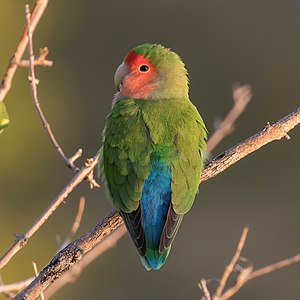Wikipedia:Picture of the day/October 2022
|
Featured picture tools: |
These featured pictures, as scheduled below, appeared as the picture of the day (POTD) on the English Wikipedia's Main Page in October 2022. Individual sections for each day on this page can be linked to with the day number as the anchor name (e.g. [[Wikipedia:Picture of the day/October 2022#1]] for October 1).
You can add an automatically updating POTD template to your user page using {{Pic of the day}} (version with blurb) or {{POTD}} (version without blurb). For instructions on how to make custom POTD layouts, see Wikipedia:Picture of the day.Purge server cache
October 1
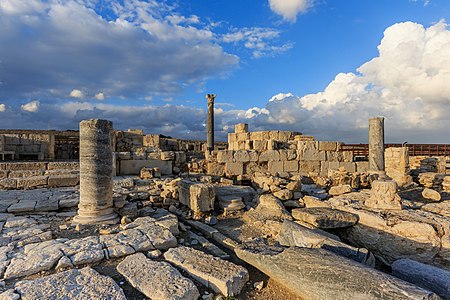
|
|
Kourion is an ancient city-state on the southwestern coast of the island of Cyprus, located near modern Limassol, that existed from antiquity until the Middle Ages. Built in the 12th century BC by Mycenaeans who took part in the Trojan War, Kourion was later controlled by the Greeks, Romans, and Byzantines. The settlement was placed on a 70-metre-high (230 ft) cliff to ensure the safety of its citizens. The modern archaeological site is managed by the Department of Antiquities of Cyprus and includes the ruins of the stadium and the sanctuary of Apollo Hylates. This photograph depicts the ruins of Kourion's agora, a central public space in the city-state. Photograph credit: Alexander Savin
Recently featured:
|
October 2
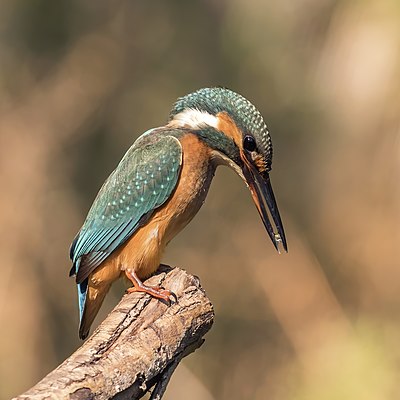
|
The common kingfisher (Alcedo atthis), also known as the Eurasian kingfisher or the river kingfisher, is a small species of kingfisher with seven subspecies recognized within its wide distribution across Eurasia and northern Africa. It is resident in much of its range, but migrates from areas where rivers freeze in winter. Like all kingfishers, the common kingfisher is highly territorial; since it must eat around 60 per cent of its body weight each day, it is essential to have control of a suitable stretch of river. It is solitary for most of the year, roosting alone in heavy cover. If another kingfisher enters its territory, both birds display from perches, and fights may occur, in which a bird will grab the other's beak and try to hold it underwater. Pairs form in the autumn but each bird retains a separate territory, generally at least 1 km (0.6 mi) long but up to 3.5 km (2.2 mi), and territories are not merged until the spring. This female common kingfisher, of the subspecies A. a. ispida, was photographed near Kecskemét in Hungary. Photograph credit: Charles J. Sharp
Recently featured:
|
October 3

|
La Navarraise is an opera in two acts by Jules Massenet to a French libretto by Jules Claretie and Henri Caïn, based on Claretie's short story La cigarette (1890). This poster, for the French première at the Théâtre de l'Opéra-Comique on 3 October 1895, features Emma Calvé in the role of Anita. Photograph credit: Reutlinger family; restored by Adam Cuerden
Recently featured:
|
October 4

|
Jean-François Millet (October 4, 1814 – January 20, 1875) was a French artist and one of the founders of the Barbizon school in rural France. Millet is noted for his paintings of peasant farmers. This portrait of Millet was taken by the French photographer Nadar. Photograph credit: Nadar; restored by Adam Cuerden
Recently featured:
|
October 5
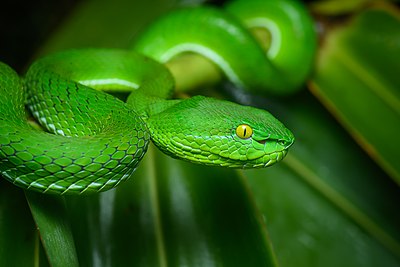
|
Trimeresurus gumprechti, commonly known as Gumprecht's green pit viper, is a species of venomous pit viper in the family Viperidae. Endemic to Asia, it is found in parts of China, Laos, Myanmar, Thailand, and Vietnam, and is strikingly bright green in color. This female T. gumprechti snake was photographed in Phu Suan Sai National Park in northern Thailand. Photograph credit: Rushen
Recently featured:
|
October 6

|
|
Serge Gainsbourg (1928–1991) was a French musician, singer-songwriter, actor, author and filmmaker. Regarded as one of the most important figures in French pop music, he was renowned for often provocative and scandalous releases which caused uproar in France, dividing its public opinion, as well as his diverse artistic output, which ranged from his early work in jazz, chanson, and yé-yé to later efforts in rock, zouk, funk, reggae, and electronica. He is often regarded as one of the world's most influential popular musicians. His lyrical works incorporated wordplay, with humorous, bizarre, provocative, sexual, satirical or subversive overtones. Gainsbourg's music has reached legendary stature in France, and he has become one of the country's best-loved public figures. He has also gained a cult following all over the world with chart success in the United Kingdom and Belgium with "Je t'aime... moi non plus" and "Bonnie and Clyde", respectively. This photo of Gainsbourg was taken in 1981. Photograph credit: Claude Truong-Ngoc
Recently featured:
|
October 7

|
|
The Alcázar of Segovia is a medieval castle located in the city of Segovia in Castile and León, Spain. Rising out on a rocky crag above the confluence of two rivers near the mountains of Guadarrama, it is one of the most distinctive castle-palaces in Spain by virtue of its shape, resembling the bow of a ship. The alcázar was originally built in the 11th or 12th century by the Almoravid dynasty as a fortress, but has since served as a royal palace where twenty-two kings reigned, a state prison, a royal artillery college, and a military academy. The castle overlooks a valley with the Eresma River and is a symbol of the old city of Segovia. It was declared a UNESCO World Heritage Site in 1985. Today, the alcázar is used as a museum and a military archives building since its declaration as a national archive by royal decree in 1998. Photograph credit: Rafa Esteve
Recently featured:
|
October 8
|
The rosy-faced lovebird (Agapornis roseicollis), also known as the rosy-collared or peach-faced lovebird, is a species of lovebird native to arid regions in southwestern Africa such as the Namib. A loud and constant chirper, they are very social and often congregate in small groups in the wild. They eat throughout the day and take frequent baths. Coloration can vary widely among populations, and plumage is identical in males and females. Lovebirds are renowned for their sleep position in which they sit side-by-side and turn their faces in towards each other. Females are well noted to tear raw materials into long strips, "twisty-tie" them onto their backs, and fly substantial distances back to make a nest. These photographs of a rosy-faced lovebird of the subspecies A. r. roseicollis, seen from the front (top) and the back (bottom), were taken in Erongo Region, Namibia. Photograph credit: Charles J. Sharp
Recently featured:
|
October 9

|
The Sky Reflector-Net at Fulton Center, a subway and retail complex centered at the intersection of Fulton Street and Broadway in Lower Manhattan, New York City. The Sky Reflector-Net, which was commissioned by the MTA Arts & Design (the art program of the MTA), was installed in 2014 in the Fulton Center transit hub. Located at the center of the oculus, the Sky Reflector-Net uses hundreds of aluminum mirrors to provide natural sunlight from a 53 ft (16 m) skylight to an underground area as much as four stories deep. Photograph credit: User:Rhododendrites
Recently featured:
|
October 10

|
|
Franchise Tax Board of California v. Hyatt was a 2019 United States Supreme Court case that determined that, unless they consent, states have sovereign immunity from private lawsuits filed against them in the courts of another state. The 5–4 decision overturned precedent set in the 1979 Supreme Court case Nevada v. Hall. This was the litigants' third time presenting their case to the Supreme Court, which had previously ruled on the issue initially in 2003 and subsequently in 2016. This courtroom sketch by the American sketch artist Arthur Lien depicts Erwin Chemerinsky presenting oral arguments for the respondent in the 2019 case, with the Supreme Court justices Elena Kagan and Brett Kavanaugh looking on in the background. Illustration credit: Arthur Lien
Recently featured:
|
October 11

|
|
The red knot (Calidris canutus), or simply known as the knot in English-speaking Europe, is a medium-sized shorebird that breeds in tundra and the Arctic Cordillera in the far north of Canada, Europe, and Russia. It is a large sandpiper in the genus Calidris, second only to the great knot. Six subspecies are recognised. Its diet varies according to season; arthropods and larvae are the preferred food items at the breeding grounds, while various hard-shelled molluscs are consumed at other feeding sites at other times. North American breeders migrate to coastal areas in Europe and South America, while the Eurasian populations winter in Africa, Papua New Guinea, Australia, and New Zealand. The species forms enormous flocks when not breeding. This red knot was photographed in Boat Harbour in New South Wales, Australia. Photograph credit: John Harrison |
October 12

|
Eva Le Gallienne (1899–1991) was a British-born American stage actress, producer, director, translator, and author. A Broadway star by age 21, Le Gallienne gave up her Broadway appearances to devote herself to founding the Civic Repertory Theatre, in which she was both director, producer, and lead actress. Noted for her boldness and idealism, she became a pioneering figure in the American repertory movement, which enabled today's off-Broadway. A versatile and eloquent actress herself (playing roles ranging from Peter Pan to Hamlet), Le Gallienne also became a respected stage director, coach, producer and manager. Photograph credit: Nicholas Haz; restored by Coffeeandcrumbs
Recently featured:
|
October 13

|
|
The Komodo dragon (Varanus komodoensis), also known as the Komodo monitor, is a species of monitor lizard in the family Varanidae that is endemic to the Indonesian islands of Komodo, Rinca, Flores, and Gili Motang. It is the largest extant species of lizard, growing to a maximum length of 3 metres (10 ft), and weighing up to approximately 70 kilograms (150 lb). The Komodo dragon prefers hot and dry places, and typically lives in dry, open grassland, savanna, and tropical forest at low elevations. As an ectotherm, it is most active in the day, although it exhibits some nocturnal activity. Komodo dragons are solitary, coming together only to breed and eat. They are capable of running rapidly in brief sprints up to 20 km/h (12 mph), diving up to 4.5 metres (15 ft), and climbing trees proficiently when young through use of their strong claws. To catch out-of-reach prey, it may stand on its hind legs and use its tail as a support. As it matures, its claws are used primarily as weapons, as its great size makes climbing impractical. This photograph of two Komodo dragons fighting was taken on the island of Rinca, within Komodo National Park. Photograph credit: Charles J. Sharp
Recently featured:
|
October 14
|
A mudpot, or mud pool, is a type of acidic hot spring, or fumarole, with limited water. It usually takes the form of a pool of bubbling mud. The acid and microorganisms decompose surrounding rock into clay and mud. The mud of a mudpot takes the form of a viscous, often bubbling, slurry. As the boiling mud is often squirted over the brims of the mudpot, a sort of mini-volcano of mud starts to build up, sometimes reaching heights of 1 to 1.5 meters (3 to 5 ft). The mud is generally of white to greyish color, sometimes stained with reddish or pink spots from iron compounds. When the slurry is particularly colorful, the feature may be referred to as a paint pot. This video of a bubbling mudpot was captured in Lassen Volcanic National Park in northern California. Video credit: Frank Schulenburg
Recently featured:
|
October 15
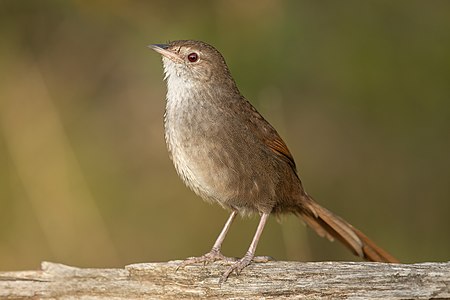
|
|
The eastern bristlebird (Dasyornis brachypterus) is a species of bird in the bristlebird family, Dasyornithidae. Endemic to Australia, its natural habitats are temperate forests, shrublands and grasslands. It is considered to be a vulnerable species by the International Union for Conservation of Nature and listed as endangered in Australian legislation, being threatened by habitat loss and a lack of genetic diversity. This eastern bristlebird was photographed near Currarong, on the coast of New South Wales. Photograph credit: John Harrison
Recently featured:
|
October 16

|
David Ben-Gurion (16 October 1886 – 1 December 1973) was the primary national founder of the State of Israel and the first prime minister of the country. Born David Grün, he adopted the surname Ben-Gurion in 1909, and later rose to become the preeminent leader of the Jewish community in British-ruled Mandatory Palestine from 1935 until the establishment of the State of Israel in 1948, which he led until 1963 with a short break between 1954 and 1955. This photograph of Ben-Gurion was taken in 1960 and is part of Israel's National Photo Collection. Photograph credit: Fritz Cohen
Recently featured:
|
October 17

|
The purple roller (Coracias naevius), also known as the rufous-crowned roller, is a medium-sized species of bird in the family Coraciidae widespread in sub-Saharan Africa. Compared with other rollers its colours are rather dull and its voice rather harsh and grating. Its preferred habitat is dry thornveld, where it spends long periods perched at the top of thorn trees or poles, watching for food items such as insects, spiders, scorpions and small lizards on the ground. It rocks to-and-fro about its longitudinal axis during display flights, calling raucously all the while; starting from above the treetops it plummets towards the ground in rolling flight. The species is territorial, and during the breeding season it will drive off other rollers, small hawks, and crows. This purple roller, of the subspecies C. n. mosambicus, was photographed in Etosha National Park, Namibia. Photograph credit: Charles J. Sharp
Recently featured:
|
October 18

|
|
Government House is a government building in the city of Baku, housing various state ministries of Azerbaijan. It was constructed between 1936 and 1952 as the Baku Soviet Palace, to house the administration of the Azerbaijan Soviet Socialist Republic. Designed by Lev Rudnev in the Baroque style, it is located on the shore of the Caspian Sea. Photograph credit: Diego Delso
Recently featured:
|
October 19

|
The red-billed gull (Chroicocephalus novaehollandiae scopulinus), also known as the tarāpung, is a member of the gull family, Laridae. Endemic to New Zealand, it is found throughout the country and on outlying islands including the Chatham Islands and the New Zealand Subantarctic Islands. Formerly considered a separate species, it is now usually treated as a subspecies of the silver gull. It regularly feeds on small fish, shellfish and worms, and sometimes berries, lizards and insects; it scavenges among urban waste in coastal towns. This red-billed gull was photographed in Christchurch. Photograph credit: Michal Klajban
Recently featured:
|
October 20
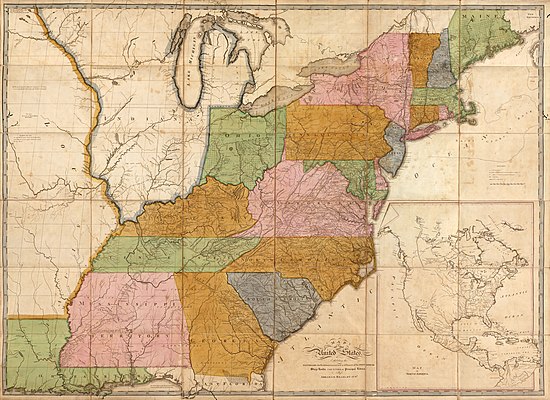
|
|
Abraham Bradley Jr. (1767–1838) was an American lawyer, judge, and cartographer who served as Assistant Postmaster General for 30 years during the earliest history of the United States Post Office Department. He was responsible for moving the federal government's post office from Philadelphia, Pennsylvania, to the new capital at Washington, D.C., and briefly hosted the national post office in his own home. The continuity brought by Bradley's long employment during the tenures of five United States postmasters general helped establish the budding postal service as a reliable provider; he also drew detailed and innovative postal route maps that built the office's efficiency. He drew one of the first comprehensive maps of the United States in 1796; it "represented the first clear cartographic break in European-dominated map making and introduced a new, more distinctly American style of cartography to the United States". In 1804, Bradley drew this map of American post roads and post offices, spanning the Orleans Territory (now Louisiana) in the southwest to Maine in the northeast. The hand-colored map measures 98 by 132 centimeters (39 in × 52 in). Map credit: Abraham Bradley Jr.
Recently featured:
|
October 21

|
|
The rose robin (Petroica rosea) is a small species of passerine bird native to Australia. It tends to feed in the tops of trees, with insects and spiders forming the bulk of its diet, most being caught while it is in flight. Unlike other robins, it does not return to the same branch while foraging. Its prey consists of a variety of spiders and insects, including caterpillars, wasps, bugs such as cicadas and cinch bugs, beetles, weevils, flies and ants. This rose robin was photographed in the Blue Mountains National Park, near Woodford, New South Wales. Photograph credit: John Harrison
Recently featured:
|
October 22

|
Alexander Fleming (1881–1955) was a Scottish physician and microbiologist, best known for discovering the world's first broadly effective antibiotic substance, which he named penicillin. His discovery in 1928 of what was later named benzylpenicillin (or penicillin G) from the mould Penicillium rubens is described as the "single greatest victory ever achieved over disease." For this discovery, he shared the Nobel Prize in Physiology or Medicine in 1945 with Howard Florey and Ernst Chain. Photograph credit: unknown
Recently featured:
|
October 23

|
Lichfield Cathedral, in Lichfield, Staffordshire, is the only medieval English cathedral with three spires. The cathedral suffered severe damage during the English Civil War in which all of the stained glass was destroyed. In spite of this, the windows of the Lady Chapel contain some of the finest medieval Flemish painted glass in existence. Dating from the 1530s, it came from Herkenrode Abbey in Belgium, in 1801, having been purchased by Sir Brooke Boothby when that abbey was dissolved during the Napoleonic Wars. It was sold on to the cathedral for the same price. There are also some fine windows by Betton and Evans (1819), and many fine late-19th-century windows, particularly those by Charles Eamer Kempe. This photograph depicts part of cathedral's nave, depicting the column structure on the wall. Photograph credit: David Iliff
Recently featured:
|
October 24

|
The sociable weaver (Philetairus socius) is a species of bird in the weaver family, Ploceidae, endemic to southern Africa. It is the only species in the monotypic genus Philetairus. The bird is found in South Africa, Namibia, and Botswana, with its range centred within the South African province of Northern Cape. They build large compound community nests, which are amongst the largest built by any avian species and capable of housing more than a hundred pairs of birds. This sociable weaver was photographed perching on a branch in Tswalu Kalahari Reserve, South Africa. Photograph credit: Charles J. Sharp
Recently featured:
|
October 25
|
The Old Royal Naval College is the architectural centrepiece of Maritime Greenwich, a World Heritage Site in Greenwich, London, described by the United Nations Educational, Scientific and Cultural Organization as the "finest and most dramatically sited architectural and landscape ensemble in the British Isles". The buildings were originally constructed to serve as the Royal Hospital for Seamen at Greenwich, now generally known as Greenwich Hospital, which was chartered by King William III and Queen Mary II on 25 October 1694, designed by Christopher Wren, and built between 1696 and 1712. The hospital closed in 1869. Between 1873 and 1998 it housed the Royal Naval College, Greenwich. This panoramic photograph depicts the two buildings of the Old Royal Naval College viewed from across the River Thames, with the Queen's House visible in the background in between. Photograph credit: Colin
Recently featured:
|
October 26

|
Arthur Kornberg (March 3, 1918 – October 26, 2007) was an American biochemist who won the Nobel Prize in Physiology or Medicine 1959 for his discovery of "mechanisms in the biological synthesis of ribonucleic acid and deoxyribonucleic acid" (RNA and DNA) together with Spanish biochemist and physician Severo Ochoa of New York University. Photograph credit: NIH History Office; restored by Bammesk
Recently featured:
|
October 27
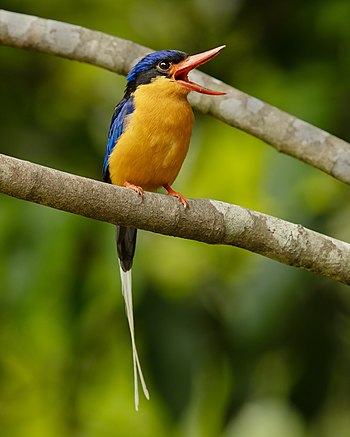
|
The buff-breasted paradise kingfisher (Tanysiptera sylvia) is a bird in the tree kingfisher subfamily. It migrates in November from New Guinea to its breeding grounds in the rainforest of North Queensland, Australia. Despite its bright colours, the buff-breasted paradise kingfisher is often difficult to see in the rainforest and is best located by its distinctive calls. The buff-breasted paradise kingfisher hunts on the ground and from the foliage in the middle to lower levels of the forest canopy. It feeds on phasmids, earthworms, beetles, insect larvae, spiders, skinks and small frogs, snails and one was observed holding a small tortoise. The young are fed by both parents. Photograph credit: JJ Harrison
Recently featured:
|
October 28
United States Notes are a type of paper money that was issued from 1862 to 1971 in the United States, longer than any other form of U.S. paper money. They were known popularly as "greenbacks", a name inherited from the earlier greenbacks that they replaced in 1862. Often termed Legal Tender Notes, they were named United States Notes by the First Legal Tender Act, which authorized them as a form of fiat money. During the early 1860s the so-called second obligation on the reverse of the notes stated: "This Note is a Legal Tender for all debts public and private except Duties on Imports and Interest on the Public Debt; and is receivable in payment of all loans made to the United States." These nine United States Notes, in denominations from $1 to $1000, were issued in 1880. Each bears the signatures of the register of the Treasury and the treasurer of the United States, and a portrait of a different individual, identified above. The banknotes are part of the National Numismatic Collection at the Smithsonian Institution. Banknote design credit: Bureau of Engraving and Printing; scanned by Andrew Shiva
Recently featured:
|
October 29

|
|
Plexippus petersi is a species of jumping spider native to Asia and has been introduced to Africa and the Pacific Islands. The male is between 6 and 10 millimetres (0.24 and 0.39 in) in length, and the female around 10 millimetres (0.39 in). Plexippus petersi is a house spider, living indoors, and is noted for the skilful way it hunts and catches mosquitoes, flies and other invertebrates. It has also been found living in crops in the Philippines, in one instance in a rice field infested with the armyworm Spodoptera mauritia, and in another, in a corn field attacked by the northern armyworm Mythimna separata. This focus-stacked photograph depicts a P. petersi spider, approximately 7 millimetres (0.28 in) in length, on a human finger. Photograph credit: Basile Morin
Recently featured:
|
October 30
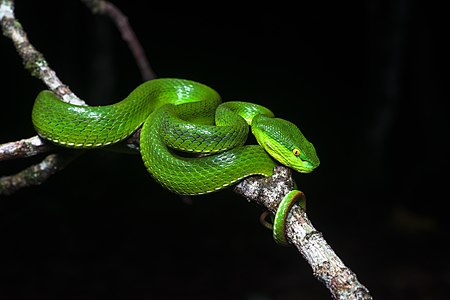
|
|
Trimeresurus albolabris, the white-lipped pit viper or white-lipped tree viper, is a venomous pit viper species endemic to Southeast Asia. Its meals consist of birds, small frogs, and small mammals. This snake does not strike and release its prey; like many arboreal snakes, it strikes and holds on to the prey item until the prey dies. This photograph was taken in Thailand's Kaeng Krachan National Park. Photograph credit: Rushen
Recently featured:
|
October 31
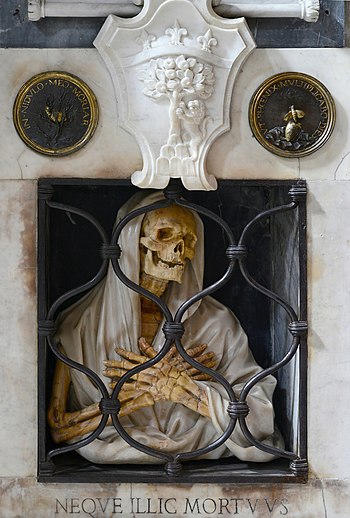
|
Tomb of the architect Giovanni Battista Gisleni (1600–1672) in the church of Santa Maria del Popolo, Rome. The figure of a skeleton was sculpted by the architect. The carved text reads Neque hic vivus (not visible in this image) and Neque illic mortuus (Latin: "Neither living here — nor dead there"). Text in the two tondi (circles) reads In nidulo meo moriar ("In my nest I die" i.e. in Rome) and Ut phoenix multiplicabo dies ("As a phoenix I multiply my days"). credit: Joaquim Alves Gaspar
Recently featured:
|
Picture of the day archives and future dates


